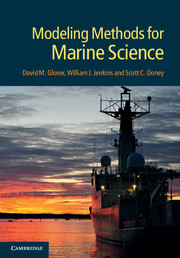Book contents
- Frontmatter
- Contents
- Preface
- 1 Resources, MATLAB primer, and introduction to linear algebra
- 2 Measurement theory, probability distributions, error propagation and analysis
- 3 Least squares and regression techniques, goodness of fit and tests, and nonlinear least squares techniques
- 4 Principal component and factor analysis
- 5 Sequence analysis I: uniform series, cross- and autocorrelation, and Fourier transforms
- 6 Sequence analysis II: optimal filtering and spectral analysis
- 7 Gridding, objective mapping, and kriging
- 8 Integration of ODEs and 0D (box) models
- 9 A model building tutorial
- 10 Model analysis and optimization
- 11 Advection–diffusion equations and turbulence
- 12 Finite difference techniques
- 13 Open ocean 1D advection–diffusion models
- 14 One-dimensional models in sedimentary systems
- 15 Upper ocean 1D seasonal models
- 16 Two-dimensional gyre models
- 17 Three-dimensional general circulation models (GCMs)
- 18 Inverse methods and assimilation techniques
- 19 Scientific visualization
- Appendix A Hints and tricks
- References
- Index
7 - Gridding, objective mapping, and kriging
Published online by Cambridge University Press: 05 June 2012
- Frontmatter
- Contents
- Preface
- 1 Resources, MATLAB primer, and introduction to linear algebra
- 2 Measurement theory, probability distributions, error propagation and analysis
- 3 Least squares and regression techniques, goodness of fit and tests, and nonlinear least squares techniques
- 4 Principal component and factor analysis
- 5 Sequence analysis I: uniform series, cross- and autocorrelation, and Fourier transforms
- 6 Sequence analysis II: optimal filtering and spectral analysis
- 7 Gridding, objective mapping, and kriging
- 8 Integration of ODEs and 0D (box) models
- 9 A model building tutorial
- 10 Model analysis and optimization
- 11 Advection–diffusion equations and turbulence
- 12 Finite difference techniques
- 13 Open ocean 1D advection–diffusion models
- 14 One-dimensional models in sedimentary systems
- 15 Upper ocean 1D seasonal models
- 16 Two-dimensional gyre models
- 17 Three-dimensional general circulation models (GCMs)
- 18 Inverse methods and assimilation techniques
- 19 Scientific visualization
- Appendix A Hints and tricks
- References
- Index
Summary
To those devoid of imagination, a blank place on the map is a useless waste; to others, the most valuable part.
Aldo LeopoldMost of you are familiar with topographic contour maps. Those squiggly lines represent locations on the map of equal elevation. Many of you have probably seen a similar mode of presentation for scientific data, contour plots with isolines of constant property values (e.g. isotherms and isopycnals). What many of you are probably not familiar with are the mathematics that lie behind the creation of those “maps” and their uses beyond visualization.
Contouring and gridding concepts
This chapter covers the question: “What do you do when your data are not on a regular grid?” This question comes up frequently with ocean field data, which are rarely sampled at exactly equal intervals of space or time. The grid dimensions could be latitude–longitude, like the familiar topographic map, or involve other dimensions such as time, depth, or even property values (e.g. temperature, oxygen, chlorophyll). Mathematical gridding is common in visualization because computers can only draw contour lines if they know where to draw them. Often, a contouring package will first grid your data using a default method, and this may be acceptable. But there is more to it than making pretty pictures.
- Type
- Chapter
- Information
- Modeling Methods for Marine Science , pp. 171 - 193Publisher: Cambridge University PressPrint publication year: 2011



